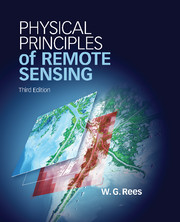Book contents
- Frontmatter
- Contents
- Preface
- Acknowledgements
- 1 Introduction
- 2 Electromagnetic waves in free space
- 3 Interaction of electromagnetic radiation with matter
- 4 Interaction of electromagnetic radiation with the Earth's atmosphere
- 5 Photographic systems
- 6 Electro-optical systems
- 7 Passive microwave systems
- 8 Ranging systems
- 9 Scattering systems
- 10 Platforms for remote sensing
- 11 Data processing
- Appendix Data tables
- References
- Index
- Plate Section
4 - Interaction of electromagnetic radiation with the Earth's atmosphere
Published online by Cambridge University Press: 05 December 2012
- Frontmatter
- Contents
- Preface
- Acknowledgements
- 1 Introduction
- 2 Electromagnetic waves in free space
- 3 Interaction of electromagnetic radiation with matter
- 4 Interaction of electromagnetic radiation with the Earth's atmosphere
- 5 Photographic systems
- 6 Electro-optical systems
- 7 Passive microwave systems
- 8 Ranging systems
- 9 Scattering systems
- 10 Platforms for remote sensing
- 11 Data processing
- Appendix Data tables
- References
- Index
- Plate Section
Summary
In Chapter 3 we discussed principally the interaction of electromagnetic radiation with the surface and bulk of the material being sensed. However, the radiation also has to make at least one journey through at least part of the Earth's atmosphere, and two such journeys in the case of systems that detect reflected radiation, whether artificial or naturally occurring. Each time radiation passes through the atmosphere it is attenuated to some extent. In addition, as we have already seen in Section 3.1.2 and Figure 3.5, the atmosphere has a refractive index that differs from unity so that radiation travels through it at a speed different from the free-space speed of 299 792 458 m s−1. These phenomena must be considered if the results of a remotely sensed measurement are to be corrected for the effects of atmospheric propagation, or if they are to be used to infer the properties of the atmosphere itself. We have already considered them in general terms in discussing the radiative transfer equation (Section 3.4). In this chapter we shall relate them more directly to the constituents of the atmosphere.
Composition and structure of the gaseous atmosphere
At sea level, the principal constituents of the dry atmosphere are molecules of nitrogen (about 78% by volume), oxygen (21%) and the inert gas argon (1%). There is also a significant but variable (typically 0.1% to 3%) amount of water vapour, often specified by the relative humidity H.
- Type
- Chapter
- Information
- Physical Principles of Remote Sensing , pp. 110 - 134Publisher: Cambridge University PressPrint publication year: 2012



